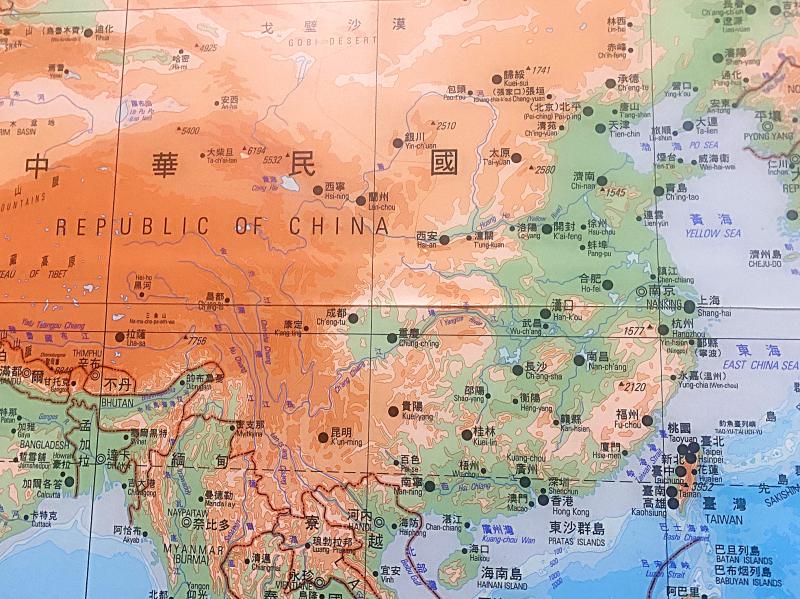Lawmakers yesterday called for the removal or replacement of a map in the Legislative Yuan which places the capital of the Republic of China (ROC) in Nanjing, and portrays Mongolia as part of its territory.
Replacing the map with one that accurately reflects the nation is an important first step before tackling other issues, such as moving the Legislative Yuan or amending the Constitution, Democratic Progressive Party (DPP) Legislator Chen Ting-fei (陳亭妃) said.
The map, near a stairwell in one of the legislature’s buildings, often appears on TV when reporters interview legislators.

Photo: Wu Su-wei, Taipei Times
It was put up in 2016 after a previous map had been defaced, and the Chinese characters for “Taiwan” removed, a source said.
As officials were unable to purchase a replacement map large enough, they sourced one from the military, which was older with outdated markings, the source said.
Authorities at the time appended the map with the statement: “The boundaries on this map do not conform to political fact.”
“With the way it portrays the ROC territory, that map is like one from a parallel universe — it is out of step with current thinking,” Chen said.
DPP Legislator Tsai Shih-ying (蔡適應) said that the map would only “lead people to engage in fantasies,” and called on the legislature to replace it.
Hanging a factually inaccurate map in the legislature was meaningless, he said.
“That map might be confusing for foreign visitors or members of the public, especially since the map depicts Taiwan on the periphery of the ROC,” New Power Party Legislator Chiu Hsien-chih (邱顯智) said, adding that this was “unfair to the 23 million people” of Taiwan.
Chinese Nationalist Party (KMT) Legislator William Tseng (曾銘宗) said that the map is accurate, until the Constitution and laws are amended to change the nation’s official territory.
The legislature should proceed cautiously and hear the various opinions on the matter before replacing the map, he said.
Legislative Yuan Secretary-General Lin Chih-chia (林志嘉) said the legislature was already discussing the issue, and that if it could find a suitable map it would replace it.

SHIPS, TRAINS AND AUTOMOBILES: The ministry has announced changes to varied transportation industries taking effect soon, with a number of effects for passengers Beginning next month, the post office is canceling signature upon delivery and written inquiry services for international registered small packets in accordance with the new policy of the Universal Postal Union, the Ministry of Transportation and Communications said yesterday. The new policy does not apply to packets that are to be delivered to China, the ministry said. Senders of international registered small packets would receive a NT$10 rebate on postage if the packets are sent from Jan. 1 to March 31, it added. The ministry said that three other policies are also scheduled to take effect next month. International cruise ship operators

HORROR STORIES: One victim recounted not realizing they had been stabbed and seeing people bleeding, while another recalled breaking down in tears after fleeing A man on Friday died after he tried to fight the knife-wielding suspect who went on a stabbing spree near two of Taipei’s busiest metro stations, Taipei Mayor Chiang Wan-an (蔣萬安) said. The 57-year-old man, identified by his family name, Yu (余), encountered the suspect at Exit M7 of Taipei Main Station and immediately tried to stop him, but was fatally wounded and later died, Chiang said, calling the incident “heartbreaking.” Yu’s family would receive at least NT$5 million (US$158,584) in compensation through the Taipei Rapid Transit Corp’s (TRTC) insurance coverage, he said after convening an emergency security response meeting yesterday morning. National

PLANNED: The suspect visited the crime scene before the killings, seeking information on how to access the roof, and had extensively researched a 2014 stabbing incident The suspect in a stabbing attack that killed three people and injured 11 in Taipei on Friday had planned the assault and set fires at other locations earlier in the day, law enforcement officials said yesterday. National Police Agency (NPA) Director-General Chang Jung-hsin (張榮興) said the suspect, a 27-year-old man named Chang Wen (張文), began the attacks at 3:40pm, first setting off smoke bombs on a road, damaging cars and motorbikes. Earlier, Chang Wen set fire to a rental room where he was staying on Gongyuan Road in Zhongzheng District (中正), Chang Jung-hsin said. The suspect later threw smoke grenades near two exits

The Forestry and Nature Conservation Agency yesterday launched a gift box to market honey “certified by a Formosan black bear” in appreciation of a beekeeper’s amicable interaction with a honey-thieving bear. Beekeeper Chih Ming-chen (池明鎮) in January inspected his bee farm in Hualien County’s Jhuosi Township (卓溪) and found that more than 20 beehives had been destroyed and many hives were eaten, with bear droppings and paw prints near the destroyed hives, the agency said. Chih returned to the farm to move the remaining beehives away that evening when he encountered a Formosan black bear only 20m away, the agency said. The bear